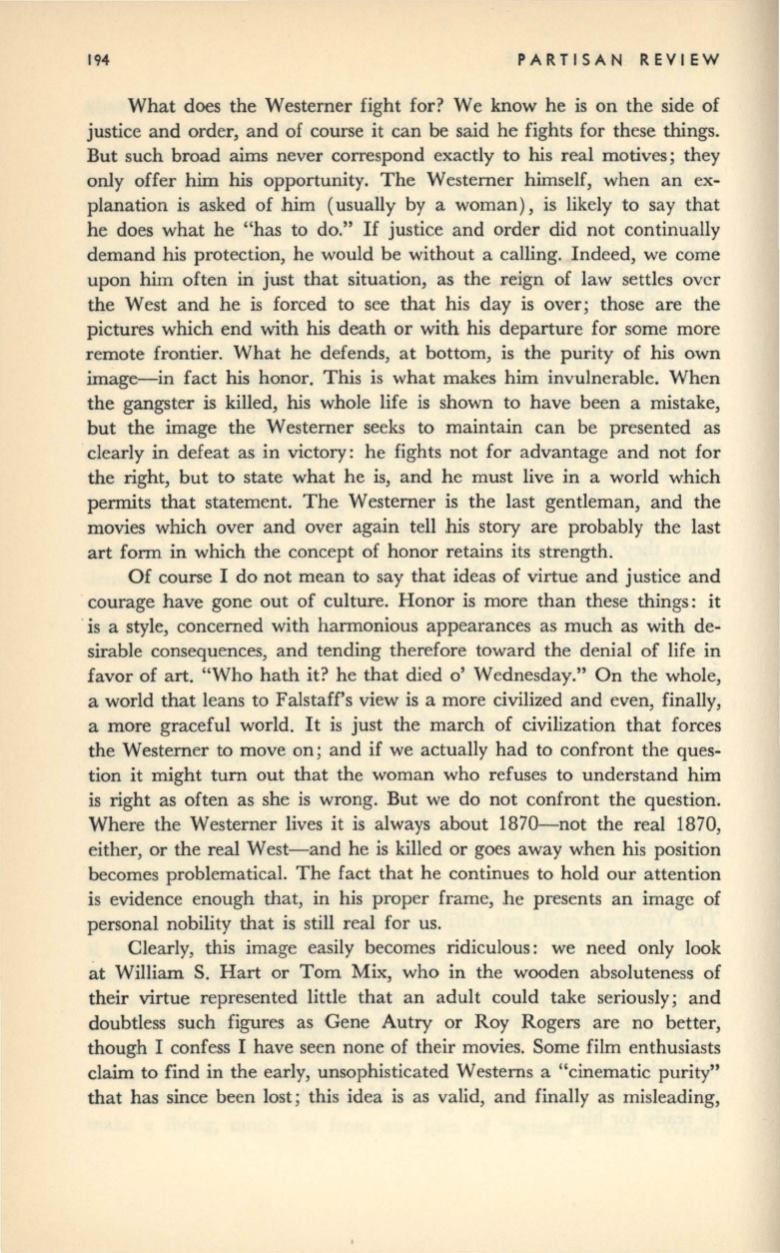
194
PARTISAN REVIEW
What does the Westerner fight for? We know he is on the side of
justice and order, and of course it can be said he fights for these things.
But such broad aims never correspond exactly to his real motives; they
only offer him his opportunity. The Westerner himself, when an ex–
planation is asked of him (usually by a woman), is likely to say that
he does what he "has to do."
If
justice and order did not continually
demand his protection, he would be without a calling. Indeed, we come
upon him often in just that situation, as the reign of law settles over
the West and he is forced to see that his day is over; those are the
pictures which end with his death or with his departure for some more
remote frontier. What he defends, at bottom, is the purity of his own
image-in fact his honor. This is what makes him invulnerable. When
the gangster is killed, his whole life is shown to have been a mistake,
but the image the Westerner seeks to maintain can be presented as
clearly in defeat as in victory: he fights not for advantage and not for
the right, but to state what he is, and he must live in a world which
permits that statement. The Westerner is the last gentleman, and the
movies which over and over again tell his story are probably the last
art form in which the concept of honor retains its strength.
Of course I do not mean to say that ideas of virtue and justice and
courage have gone out of culture. Honor is more than these things: it
.is a style, concerned with harmonious appearances as much as with de–
sirable consequences, and tending therefore toward the denial of life in
favor of art. "Who hath it? he that died
0'
Wednesday." On the whole,
a world that leans to Falstaff's view is a more civilized and even, finally,
a more graceful world. It is just the march of civilization that forces
the Westerner to move on; and if we actually had to confront the ques–
tion it might turn out that the woman who refuses to understand him
is right as often as she is wrong. But we do not confront the question.
Where the Westerner lives it is always about 1870-not the real 1870,
either, or the real West-and he is killed or goes away when his position
becomes problematical. The fact that he continues to hold our attention
is evidence enough that, in his proper frame, he presents an image of
personal nobility that is still real for us.
Clearly, this image easily becomes ridiculous: we need only look
at William S. Hart or Tom Mix, who in the wooden absoluteness of
their virtue represented little that an adult could take seriously; and
doubtless such figures as Gene Autry or Roy Rogers are no better,
though I confess I have seen none of their movies. Some film enthusiasts
claim to find in the early, unsophisticated Westerns a "cinematic purity"
that has since been lost; this idea is as valid, and finally as misleading,


